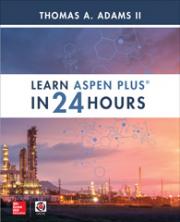Affiliation: McMaster University, Hamilton, Ontario, Canada
Reference: Thomas A. Adams II. Learn Aspen Plus in 24 Hours (McGraw-Hill Education: New York, Chicago, San Francisco, Athens, London, Madrid, Mexico City, Milan, New Delhi, Singapore, Sydney, Toronto, 2018). https://www.accessengineeringlibrary.com/content/book/9781260116458
Abstract: “The material for this book was developed at McMaster University over a 7-year period for an undergraduate course focused on problem solving strategies that use chemical process flowsheeting software. The primary objective of the course is to teach students how to solve problems relating to chemical processes and conceptual process design. The text in this book was originally intended for students to teach themselves how to use the software in a series of 12, 2-hour guided tutorials in our undergraduate computing labs…”
Comments:
In the introduction, the author mentions software competing with Aspen Plus (section C.2) and cites COCO as one such application along with Aspen HYSYS, PRO/II and ProMax. The author mentions that COCO “is built on the CAPE-OPEN framework, which is an information-exchange standard that different CAPE tools can use to interact with each other.” and also states that “It can also be integrated with any program that supports CAPE-OPEN, which includes most of the software mentioned above” which is indeed true for the competing software listed.
Furthermore the author points out that “one can potentially purchase commercial modules such as rigorous distillation models or thermodynamic property packages that are CAPE-OPEN compliant and integrate that into the free COCO flowsheet environment at potentially a lower cost than a full commercial solution.“. This is indeed what CAPE-OPEN, as implemented in COCO, allows as demonstrated at the CAPE-OPEN 2019 Annual Meeting with ProTreat from Optimized Gas Treating, Inc. in the role of advanced unit operation model and the UMPR-PRU thermodynamic model from National Technical University of Athens in the role of a CAPE-OPEN thermodynamic property package.
Next the author states that “you can use Aspen Plus to generate a CAPE-OPEN property package to use in COCO or create your own CAPE-OPEN compliant models to use in Aspen Plus.“. The possibility offered by Aspen Plus to create a CAPE-OPEN Property Package and to have it used in another PME has been exercized many times: for example when using modellers like COMSOL (presented at 5th CAPE-OPEN US Conference) or gPROMS (see foe example paper by DOMINGUES et al. or paper from WALTERS et al.). The other usage mentioned, about creating a Flowsheet in COCO and using it as a CAPE-OPEN Unit Operation in Aspen Plus, has indeed been reported at least in a paper by CORREDOR et al.
While the author shows a good understanding of what CAPE-OPEN allows, he considers CAPE-OPEN as an “advanced feature which can be useful for constructing complex and unique models” so outside the day-to-day use of process simulation tools. Is such a statement due to complexity in the access to CAPE-OPEN based functionality in a number of PMEs? If so may be worth looking at ways to propose CAPE-OPEN based functionality in a way which is neutral to the end-user.

